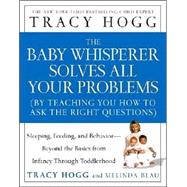New York Times bestselling author Tracy Hogg, now in a new role as "Ms. Fixit," takes us beyond the basics presented in her first two successful Baby Whisperer books. In this latest book, Hogg shares her experience in the trenches, responding to questions she has been asked repeatedly by thousands of parents who have sought her out for private consultations, flocked to her book signings, and contacted her via her website (babywhisperer.com). Here she focuses her renowned baby-whispering energies on solving the most common difficulties -- including feeding issues, sleep troubles, and behavior problems -- and puts together a comprehensive package of specific and targeted strategies.
In addition to explaining her most effective approaches in greater depth and detail, Hogg introduces a wealth of new baby-whispering concepts in these pages. She teaches parents of babies and toddlers how to catch everyday difficulties before they become chronic, as well as how to solve deeply entrenched problems. As such, The Baby Whisperer Solves All Your Problems lives up to its promise, providing a compendium of surprising and deceptively simple trouble-shooting techniques and practical remedies. For Tracy's fans, this book will be a welcome addition to the Hogg library; for readers unfamiliar with her philosophy of care, it will open a new world of understanding and insight. It is a must-have for all parents of young children, a guidebook to read from cover to cover, a resource to keep on the nightstand.









